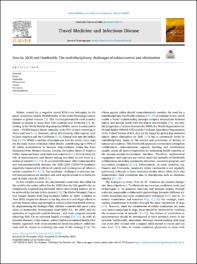Zero by 2030 and OneHealth: The multidisciplinary challenges of rabies control and elimination

Ver/
Descargar
(application/pdf: 1.611Mb)
(application/pdf: 1.611Mb)
Fecha
2022-11-21Autor(es)
Bonilla-Aldana, D. Katterine
Ruiz-Saenz, Julian
Martinez-Gutierrez, Marlen
Villamil-Gomez, Wilmer
Mantilla-Meluk, Hugo
Arrieta, German
León-Figueroa, Darwin A.
Benites-Zapata, Vicente
Barboza, Joshuan J.
Muñoz-Del-Carpio-Toia, Agueda
Franco, Oscar H.
Cabrera, Maritza
Sah, Ranjit
Al-Tawfiq, Jaffar A.
Memish, Ziad A.
Amer, Fatma A.
Suárez, José Antonio
Henao-Martinez, Andres F.
Franco-Paredes, Carlos
Zumla, Alimuddin
Rodriguez-Morales, Alfonso J.
Metadatos
Mostrar el registro completo del ítemResumen
“Rabies, caused by a negative strand RNA-virus belonging to the
genus Lyssavirus (family Rhabdoviridae of the order Mononegavirales),
remains of global concern [1]. This vaccine-preventable viral zoonotic
disease is present in more than 150 countries and territories [2]. Ac-
cording to the World Health Organization (WHO), rabies is estimated to
cause ~59,000 human deaths annually, with 95% of cases occurring in
Africa and Asia [3,4]. However, rabies still occurs in other regions, such
as Latin America and the Caribbean [5–8], Central Asia and the Middle
East [9,10]. Whilst a number of animals can host the rabies virus, dogs
are the main source of human rabies deaths, contributing up to 99% of
all rabies transmissions to humans. Dog-mediated rabies has been
eliminated from Western Europe, Canada, the United States of America
(USA), Japan and some Latin American countries [11]. Nevertheless, the
risk of reintroduction and disease among travellers to risk areas is a
matter of concern [12–15]. As occurred with many other communicable
and non-communicable diseases, the 2020–2022 COVID-19 pandemic
negatively impacted the efforts of control and reemergence of rabies in
certain countries [7,16,17]. Post-pandemic challenges to enhance con-
trol and prevention are multiple and need urgent actions to achieve the
goal in eight years by 2030 [16].“
Colecciones
- Web of Science (WOS) [236]

